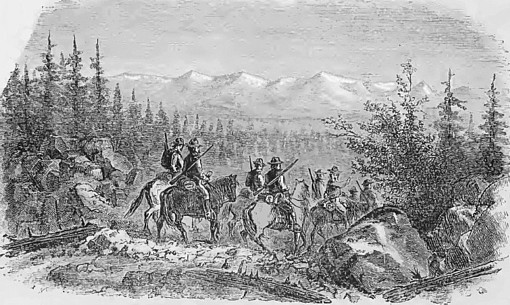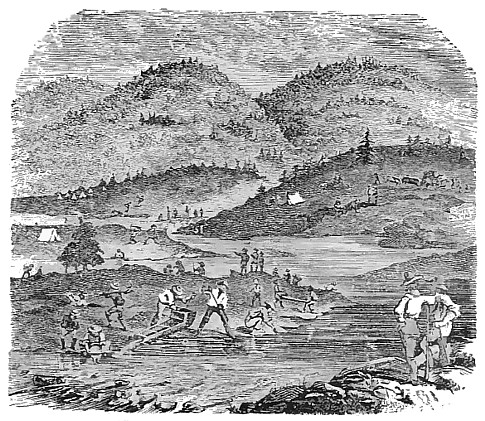The absorbing interest with which the gold-seekers proceed in their work is admirably depicted by one of the adventurers, who related these tales in a book published after his return. "Arriving on the river bar the scene presented to us was new indeed, and not more extraordinary than impressive. Some with long-handled shovels, delved among clumps of bushes, or by the side of large rocks, never raising their eyes for an instant; others with pick and shovel worked among stone and gravel, or with trowels searched under banks and roots of trees, where, if rewarded with small lumps of gold, the eye shone brighter for an instant, when the search was immediately and more ardently resumed. At the edge of the stream, or knee deep and waist deep in water, as cold as melted ice and snow could make it, some were washing gold with tin pans or the common cradle rocker, while the rays of the sun were pouring down on their heads, with an intensity exceeding any thing we ever experienced at home, though it was but the middle of April.
"The thirst for gold and the labor of acquisition overruled all else, and totally absorbed every faculty. Complete silence reigned among the miners; they addressed not a word to each other, and seemed averse to all conversation. All the sympathies of common humanity, all the finer and noble attributes of our nature seemed lost, buried beneath the soil they were eagerly delving, or swept away with the rushing waters that revealed the shining treasure."
This extract is suggestive of considerable reflection. The same amount of attention given to any pursuit must produce results equally as satisfactory as that given to gold-seeking. But gold carries with it such obvious enjoyments to the grosser minds, that the pursuit of it alone can attract their attention sufficiently to effect any thing considerable. Could the pure enjoyments connected with the practice of virtue be made as obvious to all minds, the result would be something at which the philanthropist might rejoice. The extremes of heat and cold, during the summer, in the valleys and canyons of the gold region, are very remarkable. From nine o'clock in the morning till five in the afternoon, the heat is almost intolerable.
The sun's rays pour down through an atmosphere clear and dry, and their power is increased by reflection from the sides of the canyons and mountains, and from the surface of the streams. During the night, the air becomes so cold as to render blankets very serviceable. This is caused by the waters of the different streams rising during the night, their volume being increased by the melting of the snows of the Sierra Nevada, by the heat of the previous day. Thousands of Indians, belonging to the Snake, Shoshonee, and Crow tribes, are at work at the mines. They are generally employed by some of the wealthy white men, and are paid in provisions and a sort of liquor made from California grapes, called pisco. What money or gold they get for themselves is spent in gambling—a vice to which they are most excessively addicted. Instances are not few of their having staked the produce of their labor during some weeks subsequent to the game. Many of the Indians desire no other pay than as much pisco as they can drink, with a little acorn bread. The native Californians form a goodly proportion of the gold-seekers. Many of the men are accompanied by their wives, who are attended by Indian girls. The graceful Spanish costume of the Californians adds quite a feature to the busy scene at the mines. There may be seen the long, lank forms of the Yankees, with their wide white trousers and straw hats ; the half-naked Indians ; the native born Californians, with their dusky visages and lustrous black eyes. The latter are generally clad in a short, tight jacket, with lace trimming, and velvet breeches, with a silk sash fastened round the waist.
The grizzly bear is also one of the terrors encountered by the gold-seekers. This animal grows to the size of four feet in height and six in length. It is one of the most ferocious animals of North America. Mules and cattle of various kinds, and even men, are attacked by it, and its great strength generally enables it to come off with its prey. Great quickness and courage are absolute essentials of those who hunt these animals, or encounter them accidentally. More than a few adventures happened to the gold-seekers, on their road to the mines, when accidentally meeting with a grizzly bear.
Thus life in the gold region is made up of variety and contrast. Sometimes the diggers and washers pass weeks busily engaged at their toilsome occupation, without the monotony of the time and scene being disturbed. Again, adventures and exciting incidents will be plentiful and various. At one time, pleasant weather and fandangos offer easy enjoyment ; at another, extremes of weather, hard work, and bad food render the life of the miner almost intolerable. Frequently, the gold-seeker chances to meet spots that yield ample reward for his toil; and often he works beneath the fierce rays of a broiling sun, while his legs are in chilly water, and his day's toil scarce yields more than enough to pay for his living. The trading-posts, situated at and near the mines, do a far more certain and an equally profitable business. They are generally the establishments of shrewd, speculating Yankees, who know what sort of labor is requisite to make a gold-seeker successful, and prefer to trust to the profits of bargaining in provisions and mining necessaries for gold.
That the country is pregnant with an enormous quantity of the precious metal is unquestionable. But that severe and weakening labor, together with tough constitutions, are indispensable requisites for procuring it, scarcely admits of a doubt. Very few spend any considerable time in working at the "diggings," who do not suffer from exposure, and lose a portion of their constitutional stability. So far, all attempts at the construction of machines for washing the gold from the sand, have been of little avail. Machines have been invented and carried out to the gold region by some of the numerous companies, which, upon trial, have soon been abandoned for the "cradle," and common wash pan ; but still, the field for invention is open, and the labor now necessary for procuring the gold is susceptible of considerable diminution. Of course, the means of transporting provisions and other necessaries to the mines are constantly improving, as the country is becoming settled; and thus, one great source of privation and disease is rapidly diminishing.
The form in which gold is found is various. It is sometimes crystalline, in eight or twelve-sided regular figures, passing into cubes, but the crystals are generally small and rare. In case of such crystals being found, it is well worth knowing that they possess a value as mineral specimens far beyond that of the gold which they contain. More frequently the metal is found in lumps or grains, called by the Spaniards pepitas varying in size from that of a pin's head to masses weighing, as has been already mentioned, nearly one hundred pounds troy. The term pepita is only applied to grains of some magnitude, and the most common limits of size are from that of a small pin's head to that of a nut or gooseberry.
When much smaller and still rounded, they are called gold dust, and when flattened, scales or spangles. In nature, and when seen in veins of quartz, gold often occurs foliated, or in leafy expansions of extreme thinness, or in branchy (dendrite) forms, probably made up of minute crystals. It is in the form of very minute grains that the metal is generally disseminated through rocks and auriferous ores of various metals, and these are reduced according to circumstances in methods that will he alluded to in a future chapter. In pepitas and small grains it is carried down by streams and deposited in their beds, the pepitas being usually most abundant where there is reason to suppose considerable disintegration of the surface, and where the action of denuding causes to a great extent is evident.
The mining region is constantly increasing in extent. The placers first worked still yield a profit sufficient to reward the gold seeker for his labor, and the frequent discovery of new ones by parties prospecting, keeps up the heat of excitement. The region is constantly extending towards the north. The vicinity of Trinity River is the most northern part of California where gold is obtained in any considerable quantity, and the source of the San Joaquin, is the most southern. The entire region embraced between these two points is known to abound in the precious metal, and is traversed by the gold “prospectors." Of the gold obtained, a great quantity—a third, at least, remains in the country. Another is carried out of California by the foreigners, and the remainder is sent to the Atlantic States of the Union.


